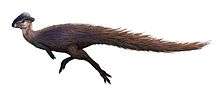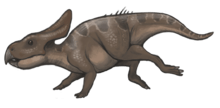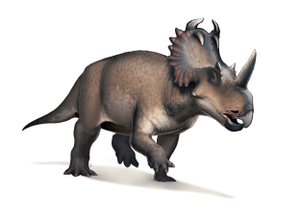Diabloceratops
Diabloceratops /daɪˌæbloʊˈsɛrətɒps/ [dee-ab-lo-ser-a-tops] is an extinct genus of centrosaurine ceratopsian dinosaur that lived approximately 79.9 million years ago during the latter part of the Cretaceous Period in what is now Utah, in the United States.[1] Diabloceratops was a medium-sized, moderately built, ground-dwelling, quadrupedal herbivore, that could grow up to an estimated 5.5 m (18.0 ft) long.[2] At the time of its discovery, it was the oldest-known ceratopsid, and first centrosaurine known from latitudes south of the U.S. state of Montana. The generic name Diabloceratops means "devil-horned face," coming from Diablo, Spanish for "devil," and ceratops, Latinised Greek for "horned face." The specific name honours Jeffrey Eaton, a paleontologist at Weber State University and long time friend of the lead author Jim Kirkland. Eaton had a big role in establishing the Grand Staircase-Escalante National Monument where the specimen was found. The type species, Diabloceratops eatoni, was named and described in 2010 by James Ian Kirkland and Donald DeBlieux.
| Diabloceratops | |
|---|---|
 | |
| Restored skull | |
| Scientific classification | |
| Kingdom: | Animalia |
| Phylum: | Chordata |
| Clade: | Dinosauria |
| Order: | †Ornithischia |
| Family: | †Ceratopsidae |
| Subfamily: | †Centrosaurinae |
| Genus: | †Diabloceratops Kirkland et al., 2010 |
| Species: | †D. eatoni |
| Binomial name | |
| †Diabloceratops eatoni Kirkland et al., 2010 | |
Discovery
The only two specimens of Diabloceratops eatoni were recovered at the Wahweap Formation, in Kane County, Utah. Type specimen UMNH VP 16699 was collected by Don DeBlieux in 2002, at the Last Chance Creek locality of this formation, in intraclastic sandstone that was deposited during the Campanian stage of the Cretaceous period, approximately 81 to 76 million years ago.[3] It consists of a partial skull with a piece of the lower jaw, with the right side being intact and part of the left side, which has been weathered. Another specimen UMNH VP 16704 was discovered years earlier in 1998 by Joshua A. Smith of the same formation, but was not described until 2010, when it was assigned to Diabloceratops. These specimens are housed in the collection of the Natural History Museum of Utah.
Description
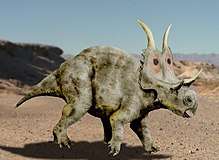
Diabloceratops was built like a typical ceratopsian in that it had a large neck frill made of bone. It had a small horn on the nose, perhaps a second horn in front of that, and a pair of relatively small horns above the eyes. The skull is deeper and shorter than that of any other centrosaurines.[4] Upon the frill it also had a pair of very long spikes as in Einiosaurus and Styracosaurus. It being one of the earliest centrosaurine ceratopsids, Kirkland noted a character Diabloceratops shared with the more "primitive" protoceratopsid forms. Both possess an accessory opening in the skull that would become much reduced or disappear in later, more advanced ceratopsids. Kirkland saw this as an indication that the earlier species were not together included in some single natural group but instead presented a gradual sequence of ever more derived forms, increasingly closer related to the Ceratopsidae.
Classification

A phylogenetic tree after a recent phylogenetic analysis by Chiba et al. (2017):[5]
| Centrosaurinae |
| |||||||||||||||||||||||||||||||||||||||||||||||||||||||||||||||||||||||||||||||||||||||||||||||||||||||||||||||
Paleoecology
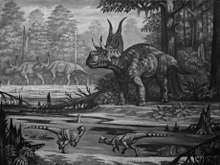
Habitat
The Wahweap Formation has been radiometrically dated as being between 81 and 76 million years old.[6] During the time that Diabloceratops lived, the Western Interior Seaway was at its widest extent, almost completely isolating southern Laramidia from the rest of North America. The area where dinosaurs lived included lakes, floodplains, and east-flowing rivers. The Wahweap Formation is part of the Grand Staircase region, an immense sequence of sedimentary rock layers that stretch south from Bryce Canyon National Park through Zion National Park and into the Grand Canyon. The presence of rapid sedimentation and other evidence suggests a wet, seasonal climate.[7]
Paleofauna
Diabloceratops shared its paleoenvironment with other dinosaurs, such as the hadrosaur Acristavus gagslarsoni,[8][9] and the lambeosaur Adelolophus hutchisoni,[10] unnamed ankylosaurs and pachycephalosaurs, and the theropod Lythronax argestes, which was likely the apex predator in its ecosystem.[11][12][13] Vertebrates present in the Wahweap Formation at the time of Diabloceratops included freshwater fish, bowfins, abundant rays and sharks, turtles like Compsemys, crocodilians,[14] and lungfish.[15] A fair number of mammals lived in this region, which included several genera of multituberculates, cladotherians, marsupials, and placental insectivores.[16] The mammals are more primitive than those that lived in the area that is now the Kaiparowits Formation. Trace fossils are relatively abundant in the Wahweap Formation, and suggest the presence of crocodylomorphs, as well as ornithischian and theropod dinosaurs.[17] In 2010 a unique trace fossil was discovered that suggests a predator-prey relationship between dinosaurs and primitive mammals. The trace fossil includes at least two fossilized mammalian den complexes as well as associated digging grooves presumably caused by a maniraptoran dinosaur. The proximity indicates a case of probable active predation of the burrow inhabitants by the animals that made the claw marks.[18] Invertebrate activity in this formation ranged from fossilized insect burrows in petrified logs[19] to various mollusks, large crabs,[20] and a wide diversity of gastropods and ostracods.[21]
See also
References
- Kirkland, J.I. and DeBlieux, D.D. (2010). "New basal centrosaurine ceratopsian skulls from the Wahweap Formation (Middle Campanian), Grand Staircase–Escalante National Monument, southern Utah", In: Ryan, M.J., Chinnery-Allgeier, B.J., and Eberth, D.A. (eds.) New Perspectives on Horned Dinosaurs: The Royal Tyrrell Museum Ceratopsian Symposium. Bloomington, Indiana University Press, pp. 117–140
- Glut, D. F., 2012, Dinosaurs, the Encyclopedia, Supplement 7: McFarland & Company, Inc, 866pp.
- J. I. Kirkland and D. D. DeBlieux. 2007. New horned dinosaurs from the Wahweap Formation, Grand Staircase-Escalante National Monument, southern Utah. Utah Geological Survey Notes 39(3):4-5
- "DIABLOCERATOPS". Retrieved 11 December 2013.
- Kentaro Chiba; Michael J. Ryan; Federico Fanti; Mark A. Loewen; David C. Evans (2018). "New material and systematic re-evaluation of Medusaceratops lokii (Dinosauria, Ceratopsidae) from the Judith River Formation (Campanian, Montana)". Journal of Paleontology. in press (2): 272–288. doi:10.1017/jpa.2017.62.
- Introduction: Kaiparowits Basin Project Overview," Getty, et al. (2010); page 479.
- Zubair A. Jinnah, #30088 (2009)Sequence Stratigraphic Control from Alluvial Architecture of Upper Cretaceous Fluvial System - Wahweap Formation, Southern Utah, U.S.A. Search and Discovery Article #30088. Posted June 16, 2009.
- Gates, T. A.; Horner, J. R.; Hanna, R. R.; Nelson, C. R. (2011). "New unadorned hadrosaurine hadrosaurid (Dinosauria, Ornithopoda) from the Campanian of North America". Journal of Vertebrate Paleontology. 31 (4): 798. doi:10.1080/02724634.2011.577854.
- "New Horned Dinosaurs from the Wahweap Formation" (PDF). Utah Geology. 2007.
- Terry A. Gates; Zubair Jinnah; Carolyn Levitt; Michael A. Getty (2014). "New hadrosaurid (Dinosauria, Ornithopoda) specimens from the lower-middle Campanian Wahweap Formation of southern Utah". In David A. Eberth; David C. Evans (eds.). Hadrosaurs: Proceedings of the International Hadrosaur Symposium. Indiana University Press. pp. 156–173. ISBN 978-0-253-01385-9.
- John Wesley Powell Memorial Museum display, visited April 30th, 2009
- "Diabloceratops eatoni". Natural History Museum of Utah. Retrieved 16 November 2013.
- http://geology.utah.gov/surveynotes/articles/pdf/horned_dinos_39-3.pdf
- Thompson, Cameron R. "A preliminary report on biostratigraphy of Cretaceous freshwater rays, Wahweap Formation and John Henry Member of the Straight Cliffs Formation, southern Utah." Abstracts with Programs - Geological Society of America, vol.36, no.4, pp.91, Apr 2004
- Orsulak, Megan et al. "A lungfish burrow in late Cretaceous upper capping sandstone member of the Wahweap Formation Cockscomb area, Grand Staircase-Escalante National Monument, Utah." Abstracts with Programs - Geological Society of America, vol. 39, no. 5, pp.43, May 2007
- Eaton, Jeffrey G; Cifelli, Richard L. "Review of Cretaceous mammalian paleontology; Grand Staircase-Escalante National Monument, Utah. Abstracts with Programs - Geological Society of America, vol.37, no.7, pp.115, Oct 2005
- Tester, Edward et al. Isolated vertebrate tracks from the Upper Cretaceous capping sandstone member of the Wahweap Formation; Grand Staircase-Escalante National Monument, UtahAbstracts with Programs - Geological Society of America, vol. 39, no. 5, pp.42, May 2007
- http://geology.gsapubs.org/content/38/8/699.abstract
- De Blieux, Donald D. "Analysis of Jim's hadrosaur site; a dinosaur site in the middle Campanian (Cretaceous) Wahweap Formation of Grand Staircase-Escalante National Monument (GSENM), southern Utah." Abstracts with Programs - Geological Society of America, vol. 39, no. 5, pp.6, May 2007
- Kirkland, James Ian. "An inventory of paleontological resources in the lower Wahweap Formation (lower Campanian), southern Kaiparowits Plateau, Grand Staircase-Escalante National Monument, Utah." Abstracts with Programs - Geological Society of America, vol.37, no.7, pp.114, Oct 2005.
- Williams, Jessica A J; Lohrengel, C Frederick. Preliminary study of freshwater gastropods in the Wahweap Formation, Bryce Canyon National Park, Utah. Abstracts with Programs - Geological Society of America, vol. 39, no. 5, pp.43, May 2007
